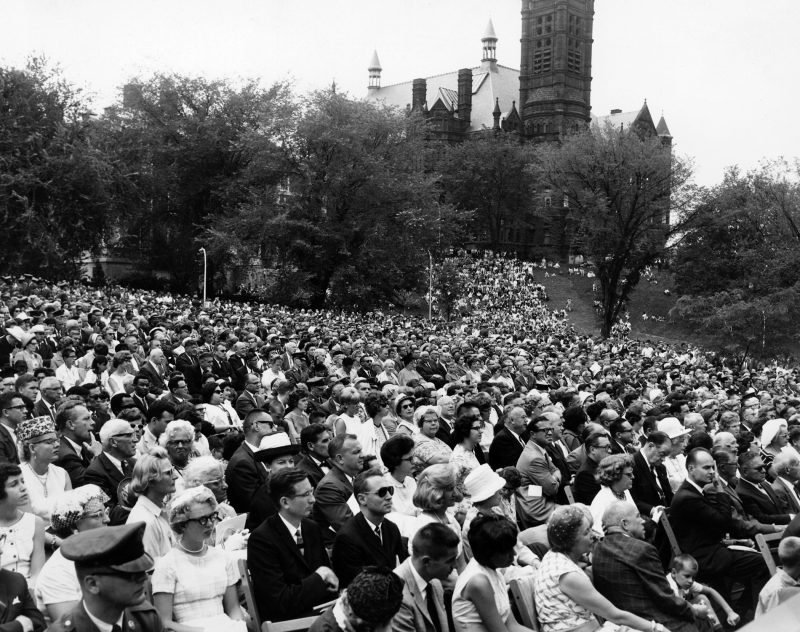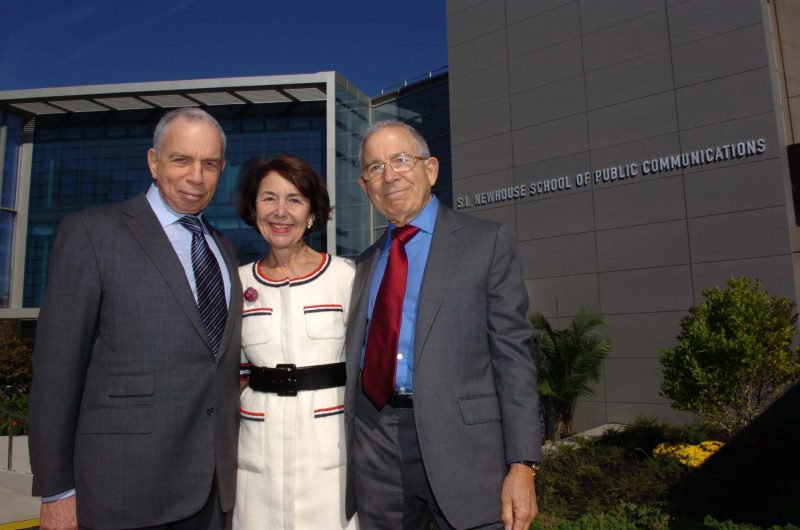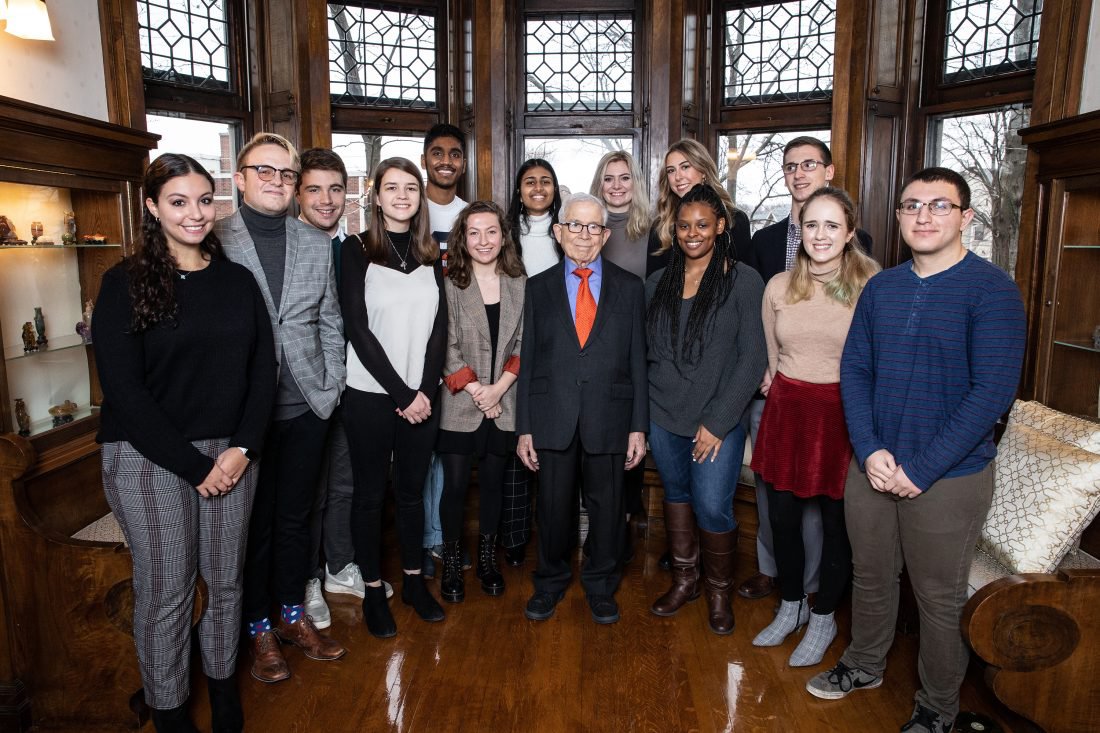‘The Eyes and Ears of Free Citizens’
Visitors to Newhouse 1 enter the building through double glass doors to find a sprawling atrium lit by skylights in the 32-foot-high ceiling. Facing the doors, above a split staircase, the wall is adorned with the Jacques Lipchitz sculpture Birth of the Muses and a quote from Samuel I. Newhouse, the late publishing magnate for whom the S.I. Newhouse School of Public Communications is named: “A free press must be fortified with greater knowledge of the world and skill in the arts of expression.”
Donald Newhouse stood in that atrium with his father on the day of the building’s dedication in 1964. He returned in January 2020 to announce a historic intention to pledge $75 million to the Newhouse School from the S.I. Newhouse Foundation, which will be the largest gift in Syracuse University history.
“The Newhouse School represented a dream of my father’s to establish the finest journalism school in the world,” Newhouse said. “That vision has come true.”
Humble Beginnings
Today regarded as one of the country’s leading schools of communications, the Newhouse School began somewhat inauspiciously in 1919 as the department of journalism in the newly founded business school at Syracuse University.
Samuel Newhouse turned 24 that year, and he had already spent seven years managing the Bayonne (New Jersey) Times on behalf of his employer. Three years later, he purchased the Staten Island Advance , and his publishing career began in earnest.
In the years that followed, Newhouse continued to acquire newspapers—including three Syracuse dailies—as well as radio and television properties, building the company that would come to be known as Advance Publications. The son of poor immigrants, he became one of the most successful media figures of the 20th century.
Those years also saw the growth of Syracuse University’s Department of Journalism, which became the School of Journalism in 1934. The school was housed in Yates Castle until 1953, when the building was sold and scheduled for demolition, forcing journalism students to attend classes in the Women’s Gymnasium and in temporary Quonset huts that had been erected on the quad. But the demise of Yates Castle, and a chance meeting a few years later, would change the course of journalism education at Syracuse University.
A Vision for Journalism Education

Samuel Newhouse met William Tolley by accident, after Newhouse mistakenly sat in a seat reserved for the Syracuse University Chancellor at a dinner in New York in the late 1950s. Though the two men were disparate in personality—Tolley was gregarious and outspoken, Newhouse was shy and taciturn—they struck up a friendship. In 1959, the year he purchased Condé Nast, Newhouse sat down with Tolley to discuss plans for a new building for the University’s journalism school.
Devoted to print media, the 74,000-square-foot Newhouse 1 included classrooms, photography darkrooms and studios, design studios, faculty offices, a library and a public lounge. The School of Journalism thrived in its new home, with enrollment increasing eightfold in the decade following the building’s dedication.

In 1971, the School of Journalism was merged with the Department of Television-Radio and renamed the S.I. Newhouse School of Public Communications on the recommendation of Chancellor Melvin Eggers. “Generally, the Syracuse approach removes the fragmentation that has tended to characterize study of journalism, broadcasting and film,” Eggers said, noting that the new school name sought to emphasize the pillars of mass media: print, film, broadcasting and recording. With that merger, the Newhouse School had become one of the most comprehensive schools of communication in the country, a designation it still holds today.
Two years later, the opening of Newhouse 2 expanded the school’s reach into broadcast and film. Among its features were two television studios, one of which was the largest in Central New York at that time. William S. Paley, chairman of the board of CBS, presided over the dedication ceremony in May 1974.

“The name Samuel I. Newhouse should be a constant reminder of a remarkable career in communications,” Paley said, noting that the building had “a significance that goes far beyond this moment and this campus.” Eggers called the Newhouse buildings “the North Star of the University.”
Newhouse was proud of the school that bore his name. “Across the land, Syracuse is recognized as a source of the best communication talent … and only the highest quality is good enough for the world of communications. … [Journalists] are the eyes and ears—and yes, the mirror—of free citizens.”
After the death of Samuel Newhouse in 1979, Donald Newhouse and his brother, S.I. Newhouse Jr., took over management of Advance Publications, which by then included 31 newspapers, seven magazines, six television stations, five radio stations and 20 cable television systems.
A New Era
The Newhouse School continued to flourish with ongoing support from the Newhouse Foundation. At the time of his initial gift, Samuel Newhouse had also established several endowments that the foundation continued to fund, providing support in the areas of scholarship, technology, doctoral education and faculty hiring, as well as an endowed chair. In addition, the Newhouse Foundation Fellowship/Internship for Minorities program was established at the school in the mid-1990s with the aim of increasing the number of people of color in newsrooms across country. The program, which continues today, provides journalism master’s students with full-tuition scholarships and on-the-job training at Advance Media New York. The foundation also established the Dean’s Leadership Fund through a two-to-one gift-matching challenge.
As the digital age brought about major changes for the communications industry and communications education, it became clear that the Newhouse School had outgrown its existing physical space. In 2003, Donald Newhouse once again stood in the atrium of Newhouse 1, this time to announce a $15 million gift to support the construction of Newhouse 3. “The school has reached a point at which it must expand to fulfill its mission,” he said. “The ever-changing, ever-increasing forms of public communication that new technologies engender have greatly multiplied the areas of expertise needed by professionals.”
By 1962, Newhouse had pledged $15 million—the largest donation in University history at that time—to fund the construction of a planned three-building complex known as the Newhouse Communications Center.
The first building, Newhouse 1, was designed by architect I.M. Pei and dedicated by President Lyndon B. Johnson on Aug. 5, 1964—Donald Newhouse’s 35th birthday. Throngs of people packed the quad to catch a glimpse of the president and first lady, who were joined on the dais by Samuel Newhouse and his family.
At a dinner the night before, Newhouse outlined his vision for the school: “In the end, it is the quality of persons who choose to make mass media their career that counts. We hope—my wife, my sons and myself—that the brightest possible young men and women will be found and awarded scholarships at this center … [and] that the most accomplished teachers who can be found will continue to be added to the present outstanding faculty as an incentive to journalism students to come to Syracuse.”

Newhouse 3 opened in September 2007 with a keynote address from U.S. Chief Justice John G. Roberts. Wrapped in the words of the First Amendment, the 74,000-squarefoot addition to the Newhouse complex included the Collaborative Media Room, the Center for Digital Convergence, research suites and over $1 million in technology upgrades. It fulfilled the three-building vision Samuel Newhouse had first discussed with William Tolley nearly 50 years earlier.
“As it was with my father, it is our hope that the S.I. Newhouse School of Public Communications—now expanded and better integrated—will attract the inquisitive, the thoughtful, the creative, the diverse to the field of public communications and arm them with the tools to carry out their work in a manner that ensures the public’s right to know is enhanced,” Donald Newhouse said.
He returned to campus in 2014 for another of the school’s milestone moments—the rededication of Newhouse 2 following an $18 million renovation that was funded in part by the Newhouse Foundation. The building, dedicated with the help of media superstar Oprah Winfrey, features Dick Clark Studios and the Alan Gerry Center for Media Innovation. “My family and I envision a great future for the school as it changes and evolves in a field which is essential to our continuing freedom,” Newhouse said.

Securing the Future
Donald Newhouse, who was there when his father and Chancellor Tolley first conceived of the Newhouse School in 1959, received a standing ovation when he announced the transformative $75 million gift that will secure the school’s future.
The gift, which builds on the visions of former deans David Rubin and Lorraine Branham, will support multiple academic initiatives under the leadership of Mark J. Lodato, who was named Newhouse dean-designate in March and assumed the position July 1.
“The generosity of the Newhouse family is responsible for launching thousands of careers; young women and men who have become leaders in the field,” Lodato said. “Now we are in a position to assure the Newhouse School’s place as the world’s leader in communications education, offering students opportunities for generations to come.”
Though the communications industry and communications education face rapid change and uncertainty, the gift will allow Newhouse students and faculty to keep pace with that change and embrace that uncertainty.
“In this era in which public communications is undergoing continual and radical change,” Newhouse said, “my family and I expect to continue our long-term commitment to ensure that the school my dad helped found almost 60 years ago remains the leading communications school in the world for another generation.”